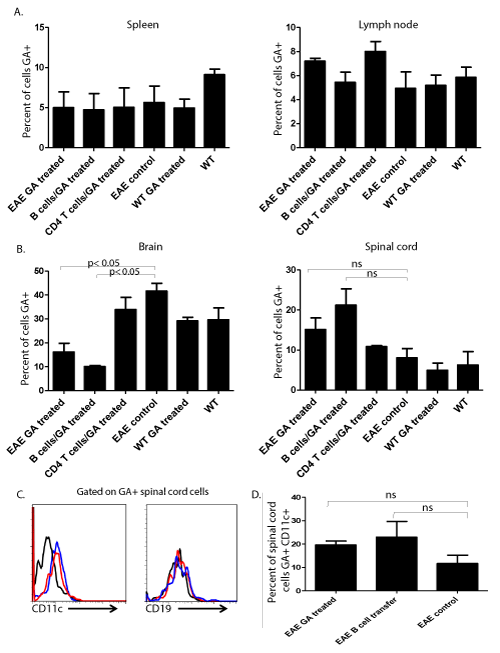
 |
| Figure 5: B cell mediated efficacy in the EAE model is associated with a decrease in GA+ cells in the brain and an increase in CD11c+ GA+ cells in the spinal cord. At the end of study the indicated organs were harvested and processed into single cells suspensions (spleen and lymph node) or underwent percoll gradient separation to obtain mononuclear cells (brain and spinal cord). The remaining cells were incubated with GA-488 and stained with markers specific for B cells, CD4 and CD8 T cells, NK cells, monocytes, and dendritic cells. The populations were analyzed using flow cytometry. (A) The percent of total GA positive cells in the spleen (left panel) or lymph node (right panel) was not statistically different. (B) The percent of total GA positive cells in the brain (left panel) was significantly reduced in GA treated EAE animals and EAE animals that received CD43- B lymphocytes from GA treated wild-type animals. The percent of total GA+ cells in the spinal cord (right panel) was increased in GA treated EAE animals and EAE animals that received CD43- B lymphocytes from GA treated wild-type animals. (C) Right panel: The percent of GA positive CD11c positive cells was increased in the spinal cord of GA treated EAE animals (red line) and EAE animals that received CD43- B lymphocytes from GA treated wild-type animals (blue line) compared to EAE control animals. The percent of GA positive CD19 positive B cells was not altered in either group compared to EAE control animals. Data is representative of two independent experiments. Right panel: Shown is the average percent ± SD of GA positive CD11c positive cells in the spinal cords of 3 independent samples from pooled spinal cords. Data is representative of two independent experiments. Statistical analysis was performed using a one-way ANOVA followed by a Bonferroni post-test. |